The Mughal Empire
The Mughal Empire was an empire that at its greatest territorial extent ruled parts of what is todays Afghanistan, Pakistan and most of the Indian Subcontinent, then known as Hindustan, between 1526 and 1707. The empire was founded by the Timurid leader Babur in 1526, when he defeated Ibrahim Lodi, the last of the Delhi Sultans at the First Battle of Panipat. "Mughal" is the Persian word for "Mongol". The religion of the Mughals was Islam.
The territory was largely conquered by the Afghan Sher Shah Suri during the time of Humayun, the second Mughal ruler, but under Akbar it grew considerably, and continued to grow until the end of Aurangzeb's rule. Jahangir, the son of Akbar, ruled the empire between 1605–1627. In October 1627, Mughal Emperor Shah Jahan, son of Jahangir, "succeeded to the throne", where he "inherited a vast and rich empire" in India; and "at mid-century this was perhaps the greatest empire in the world". Shah Jahan commissioned the famous Taj Mahal (between 1630–1653), in Agra.
The Mughals faced stiff competition from the Marathas, and after Aurangzeb died in 1707, the empire started to decline in actual power, giving way to the rise of the Hindu Maratha Empire. The Mughals however managed to maintain some trappings of power in the India for another 150 years. In 1739 it was defeated by an army from Persia led by Nadir Shah. In 1756 an army of Ahmed Shah Abdali took Delhi again. The British Empire finally dissolved it in 1857, immediately prior to which it existed only at the sufferance of the British East India Company.
Religion
The Mughal ruling class were liberal-minded Muslims, although most of the subjects of the Empire were Hindu. Although Babur founded the Empire, the dynasty remained unstable (and was even exiled) until the reign of Akbar, who was not only of liberal disposition but also intimately acquainted, since birth, with the mores and traditions of India. Under Akbar's rule, the court abolished the jizya (the poll-tax on non-Muslims) and abandoned use of the lunar Muslim calendar in favor of a solar calendar more useful for agriculture. One of Akbar's most unusual ideas regarding religion was Din-i-Ilahi ("Faith-of-God" in English), which was an eclectic mix of Hinduism, panthiestic versions of Sufi Islam,Zoroastrianism and Christianity. It was proclaimed the state religion until his death. These actions however met with stiff opposition from the Muslim clergy. However, the orthodoxy regained influence only three generations later, with Aurangzeb, known for upholding doctrines of orthodox Islam; this last of the Great Mughals retracted nearly all the liberal policies of his forbears.
| The Great Mughal Emperors |
| Emperor | Reign start | Reign end |
|---|
| Babur | 1526 | 1530 |
| Humayun | 1530 | 1540 |
| Interregnum * | 1540 | 1555 |
| Humayun | 1555 | 1556 |
| Akbar | 1556 | 1605 |
| Jahangir | 1605 | 1627 |
| Shah Jahan | 1627 | 1658 |
| Aurangzeb | 1658 | 1707 |
Establishment and reign of Babur
In the early 16th century, Muslim armies consisting of Mongol, Turkic, Persian, and Afghan warriors invaded India under the leadership of the Timurid prince Zahir-ud-Din-Mohammad Babur. Babur was the great-grandson of Mongol conqueror Timur Lenk (Timur the Lame, from which the Western name Tamerlane is derived), who had invaded India in 1398 before retiring to Samarkand who himself claimed descent from the Mongol ruler, Genghis Khan. Babur was driven from Samarkand by the Uzbeks and initially established his rule in Kabul in 1504. Later, taking advantage of internal discontent in the Delhi sultanate under Ibrahim Lodi, and following an invitation from Daulat Khan Lodi (governor of Punjab) and Alam Khan (uncle of the Sultan), Babur invaded India in 1526.
Babur, a seasoned military commander, entered India in 1526 with his well-trained veteran army of 12,000 to meet the sultan's huge but unwieldy and disunited force of more than 100,000 men. Babur defeated the Lodi sultan decisively at the first Battle of Panipat. Employing gun carts, moveable artillery, and superior cavalry tactics, Babur achieved a resounding victory and the Sultan was killed. A year later (1527) he decisively defeated, at the battle of Khanwa, a Rajput confederacy led by Rana Sanga of Chittor. A third major battle was fought in 1529 when, at the battle of Gogra, Babur routed the joint forces of Afghans and the sultan of Bengal. Babur died in 1530 at Agra before he could consolidate his military gains. He left behind as his chief legacy a set of descendants who would fulfill his dream of establishing an empire in the Indian subcontinent.
Early Sikh Gurus' perception of the Mughal Empire Babur's reign was witnessed by the first Sikh Guru Nanak Dev Ji. His Raag Asa Guru records Nanak's observations and thoughts in his poems. It says:
"Having attacked Khuraasaan, Babar terrified Hindustan. The Creator Himself does not take the blame, but has sent the Mugal as the messenger of death. There was so much slaughter that the people screamed. Didn't You feel compassion, Lord?" pg (360) On the condition of Hindu women in Babur's rule:
"Those heads adorned with braided hair, with their parts painted with vermilion - those heads were shaved with scissors, and their throats were choked with dust.They lived in palatial mansions, but now, they cannot even sit near the palaces.... ropes were put around their necks, and their strings of pearls were broken. Their wealth and youthful beauty, which gave them so much pleasure, have now become their enemies. The order was given to the soldiers, who dishonored them, and carried them away. If it is pleasing to God's Will, He bestows greatness; if is pleases His Will, He bestows punishment" pg(417-18) On the nature of Mughal rule under Babur:
"First, the tree puts down its roots, and then it spreads out its shade above. The kings are tigers, and their officials are dogs; they go out and awaken the sleeping people to harass them. The public servants inflict wounds with their nails. The dogs lick up the blood that is spilled." Source: Rag Malar, (pg.1288) Strangely enough, the land on which the Sikh Golden temple now stands, was actually donated by Mughal emperor Akbar.
Reign of Humayun
When Babur died, his son Humayun (1530–56) inherited a difficult task. He was pressed from all sides by a reassertion of Afghan claims to the Delhi throne and by disputes over his own succession. He fled to Persia, where he spent nearly ten years as an embarrassed guest of the Safavid court of Shah Tahmasp. During Sher Shah's reign, an imperial unification and administrative framework were established; this would be further developed by Akbar later in the century. In 1545, Humayun gained a foothold in Kabul with Safavid assistance and reasserted his Indian claims, a task facilitated by the weakening of Afghan power in the area after the death of Sher Shah Suri in May 1545. He took control of Delhi in 1555, but died within six months of his return, from a fall down the steps of his library.
Reign of Akbar
Humayun's untimely death in 1556 left the task of conquest and imperial consolidation to his thirteen-year-old son, Jalal-ud-Din Akbar (r.1556–1605). Following a decisive military victory at the Second Battle of Panipat in 1556, the regent Bayram Khan pursued a vigorous policy of expansion on Akbar's behalf. As soon as Akbar came of age, he began to free himself from the influences of overbearing ministers, court factions, and harem intrigues, and demonstrated his own capacity for judgment and leadership. A workaholic who seldom slept more than three hours a night, he personally oversaw the implementation of his administrative policies, which were to form the backbone of the Mughal Empire for more than 200 years. He continued to conquer, annex, and consolidate a far-flung territory bounded by Kabul in the northwest, Kashmir in the north, Bengal in the east, and beyond the Narmada River in central India.
Akbar built a walled capital called Fatehpur Sikri (Fatehpur means "town of victory") near Agra, starting in 1571. Palaces for each of Akbar's senior queens, a huge artificial lake, and sumptuous water-filled courtyards were built there. However, the city was soon abandoned and the capital was moved to Lahore in 1585. The reason may have been that the water supply in Fatehpur Sikri was insufficient or of poor quality; or, as some historians believe, that Akbar had to attend to the northwest areas of his empire and therefore moved his capital northwest. In 1599, Akbar shifted his capital back to Agra from where he reigned until his death.
Akbar adopted two distinct but effective approaches in administering a large territory and incorporating various ethnic groups into the service of his realm. In 1580 he obtained local revenue statistics for the previous decade in order to understand details of productivity and price fluctuation of different crops. Aided by Todar Mal, a hindu scholar, Akbar issued a revenue schedule that optimised the revenue needs of the state with the ability of the peasantry to pay. Revenue demands, fixed according to local conventions of cultivation and quality of soil, ranged from one-third to one-half of the crop and were paid in cash. Akbar relied heavily on land-holding zamindars to act as revenue-collectors. They used their considerable local knowledge and influence to collect revenue and to transfer it to the treasury, keeping a portion in return for services rendered. Within his administrative system, the warrior aristocracy (mansabdars) held ranks (mansabs) expressed in numbers of troops, and indicating pay, armed contingents, and obligations. The warrior aristocracy was generally paid from revenues of nonhereditary and transferable jagirs (revenue villages).
An astute ruler who genuinely appreciated the challenges of administering so vast an empire, Akbar introduced a policy of reconciliation and assimilation of Hindus (including Jodhabai, later renamed Mariam-uz-Zamani begum, the Hindu mother of his son and heir, Jahangir), who represented the majority of the population. He recruited and rewarded Hindu chiefs with the highest ranks in government; encouraged intermarriages between Mughal and Rajput aristocracy; allowed new temples to be built; personally participated in celebrating Hindu festivals such as Deepavali, or Diwali, the festival of lights; and abolished the jizya (poll tax) imposed on non-Muslims. Akbar came up with his own theory of "rulership as a divine illumination," enshrined in his new religion Din-i-Ilahi (Divine Faith), incorporating the principle of acceptance of all religions and sects. He encouraged widow re-marriage, discouraged child marriage, outlawed the practice of sati, and persuaded Delhi merchants to set up special market days for women, who otherwise were secluded at home.
By the end of Akbar's reign, the Mughal Empire extended throughout north India even south of the Narmada river. Notable exceptions were Gondwana in central India, which paid tribute to the Mughals, Assam in the northeast, and large parts of the Deccan. The area south of the Godavari river remained entirely out of the ambit of the mughals. In 1600, Akbar's Mughal empire had a revenue of £17.5 million. By comparison, in 1800, the entire treasury of Great Britain totalled £16 million.
Akbar's empire supported vibrant intellectual and cultural life. The large imperial library included books in Hindi, Persian, Greek, Kashmiri, English, and Arabic, such as the Shahnameh, Bhagavata Purana and the Bible. Akbar regularly sponsored debates and dialogues among religious and intellectual figures with differing views, and he welcomed Jesuit missionaries from Goa to his court. Akbar directed the creation of the Hamzanama, an artistic masterpiece that included 1400 large paintings.
Reigns of Jahangir and Shah Jahan
Mughal rule under Jahangir (1605–27) and Shah Jahan (1628–58) was noted for political stability, brisk economic activity, beautiful paintings, and monumental buildings. Jahangir married a Persian princess whom he renamed Nur Jehan (Light of the World), who emerged as the most powerful individual in the court besides the emperor. As a result, Persian poets, artists, scholars, and officers--including her own family members--lured by the Mughal court's brilliance and luxury, found asylum in India. The number of unproductive officers mushroomed, as did corruption, while the excessive Persian representation upset the delicate balance of impartiality at the court. Jahangir liked Hindu festivals but promoted mass conversion to Islam; he persecuted the followers of Jainism and even executed Guru Arjun Dev, the fifth saint-teacher of the Sikhs in 1606 for refusing to make changes to the Guru Granth Sahib (the Sikh holy book). The execution was not entirely for religious reasons; Guru Arjun Dev Ji supported Prince Khusro, another contestant to the Mughul throne in the civil war that developed after Akbar's death. Noor Jahan's abortive efforts to secure the throne for the prince of her choice led Shah Jahan to rebel against Jahangir in 1622. In that same year, the Persians took over Kandahar in southern Afghanistan, an event that struck a serious blow to Mughal prestige.
Between 1636 and 1646, Shah Jahan sent Mughal armies to conquer the Deccan and the lands to the northwest of the empire, beyond the Khyber Pass. Even though they aptly demonstrated Mughal military strength, these campaigns drained the imperial treasury. As the state became a huge military machine, causing the nobles and their contingents to multiply almost fourfold, the demands for revenue from the peasantry were greatly increased. Political unification and maintenance of law and order over wide areas encouraged the emergence of large centers of commerce and crafts--such as Lahore, Delhi, Agra, and Ahmadabad--linked by roads and waterways to distant places and ports.
The world-famous Taj Mahal was built in Agra during Shah Jahan's reign as a tomb for his beloved wife, Mumtaz Mahal. It symbolizes both Mughal artistic achievement and excessive financial expenditures at a time when resources were shrinking. The economic positions of peasants and artisans did not improve because the administration failed to produce any lasting change in the existing social structure. There was no incentive for the revenue officials, whose concerns were primarily personal or familial gain, to generate resources independent of what was received from the Hindu zamindars and village leaders, who, due to self-interest and local dominance, did not hand over the entirety of the tax revenues to the imperial treasury. In their ever-greater dependence on land revenue, the Mughals unwittingly nurtured forces that eventually led to the break-up of their empire.
Reign of Aurangzeb and decline of empire
The last of the great Mughals was Aurangzeb. During his fifty-year reign, the empire reached its greatest physical size but also showed unmistakable signs of decline. The bureaucracy had grown corrupt; the huge army used outdated weaponry and tactics. Aurangzeb restored Mughal military dominance and expanded power southward, at least for a while. Aurangzeb was involved in a series of protracted wars: against the Pathans in Afghanistan, the sultans of Bijapur and Golkonda in the Deccan, the Marathas in Maharashtra and the Ahoms in Assam. Peasant uprisings and revolts by local leaders became all too common, as did the conniving of the nobles to preserve their own status at the expense of a steadily weakening empire.
The increasing association of his government with Islam further drove a wedge between the ruler and his Hindu subjects. Contenders for the Mughal throne were many, and the reigns of Aurangzeb's successors were short-lived and filled with strife. The Mughal Empire experienced dramatic reverses as regional nawabs or governors broke away and founded independent kingdoms. In the war of 27 years from 1680 to 1707, the Mughals suffered several heavy defeats at the hands of the Marathas. They had to make peace with the Maratha armies, and Persian and Afghan armies invaded Delhi, carrying away many treasures, including the Peacock Throne in 1739.
Successors - "the lesser Mughals"
- Bahadur Shah I (Shah Alam I), b. October 14, 1643 at Burhanpur, ruler from 1707-1712, d. February 1712 in Lahore.
- Jahandar Shah, b. 1664, ruler from 1712-1713, d. February 11, 1713 in Delhi.
- Furrukhsiyar (b.1683, r.1713-1719, d.1719 at Delhi).
- Rafi Ul-Darjat, ruler 1719, d. 1719 in Delhi.
- Rafi Ud-Daulat (Shah Jahan II), ruler 1719, d. 1719 in Delhi.
- Nikusiyar, ruler 1719, d. 1719 in Delhi.
- Mohammed Ibrahim, ruler 1720, d. 1720 in Delhi.
- Mohammed Shah, b. 1702, ruler from 1719-1720, 1720-1748, d. April 26, 1748 in Delhi.
- Ahmad Shah Bahadur, b. 1725, ruler from 1748-1754, d. January 1775 in Delhi.
- Alamgir II, b. 1699, ruler from 1754-1759, d. 1759.
- Shah Jahan III, ruler 1760?
- Shah Alam II, b. 1728, ruler from 1759-1806, d. 1806.
- Akbar Shah II, b. 1760, ruler from 1806-1837, d. 1837.
Bahadur Shah II aka Bahadur Shah Zafar, b. 1775 in Delhi, ruler from 1837-1857, d. 1862 in exile in Rangoon, Burma. Present-day descendents: A few descendants of the last Mughal Emperor, Bahadur Shah Zafar, are known to be living in Delhi, Kolkata, and Hyderabad. The majority of direct descendants still carry the clan name Temur with four major branches today: Shokohane-Temur (Shokoh), Shahane-Temur (Shah), Bakshane-Temur (Baksh) and Salatine-Temur (Sultan). There is also a line of direct descendants who carry the name "Mirza", living in Delhi, Pakistan and England.
Contribution of Mughals to the Subcontinent
The first Mughal emperor Babur wrote in his diary Tuzk Babri: "Hindustan is a country which has few pleasures to recommend it.... Indians have no idea of the charms of friendly society, of frankly mixing together, or of familiar intercourse.... They have no horses, no good grapes, or musk melons, no good fruits, no ice or cold water, no good food or bread in their bazaars, no bath or colleges, no candles, no torches, not a candle stick." The Mughals were superior to their Indian counterparts in war but also considered themselves so culturally. They had taste for the fine things in life - for beautifully designed artifacts and the enjoyment and appreciation of cultural activities. However, the Hindus of India provided the Mughals with a richer philosophy and the plentiful spices and vegetarian options which were incorporated into modern Indian life. While the Mughals' superior position may have been appreciated, in reality, they probably borrowed as much as they gave. However, it could not be doubted that they introduced many changes to Indian society and culture, including:
- Centralised government which brought together many smaller kingdoms
- Delegated government with respect for human rights
- Persian art and culture amalgamated with native Indian art and culture
- Started new trade routes to Arab and Turk lands
- Mughalai cuisine
- Urdu and Hindi languages were formed for common Muslims and Hindus respectively
- Periods of great religious tolerance
- A style of architecture
- Landscape gardening
- A system of education that took account of pupils' needs and culture

|
| The Mughal Empire, 1526 to 1707 |
| Mughal Emperors, 1526 - 1858 |
|---|
| 1526, May 27 | Babur founds the Empire of Hind (usually referred to by historians as the Mughal Empire) |
| 1540, May 17 | Mughal rulers are expelled and superseded by the Afghan Suri dynasty |
| 1555, Jul 23 | Empire of Hind under the Mughal rulers restored |
| 1600, Dec 31 | East India Company was given monopoly privileges on all trade with the East Indies |
| 1608 | The Company's ships arrived at the port of Surat |
| 1615 | Jahangir granted the EIC the right to establish a factory at Surat |
| 1717 | EIC received a firman exempting the Company from the payment of custom duties in Bengal |
| 1757 | defeated the forces of the Nawab of Bengal, Siraj-ud-daulah , at the Battle of Plassey |
| 1773 | Lord North's India Bill, known as the Regulating Act of 1773, provided for greater parliamentary control over the affairs of the Company and placed India under the rule of a Governor-General |
| 1858, Mar 29 | the last Mughal ruler is deposed |
| 1858, Aug 2 | U.K. Act of Parliament annexes the Empire, creating British India (effective 1 Nov 1858) |
Emperors (title Padshah, sometimes Padshah-e Hind - Emperor of India)
Mughal dynasty
| Ruled | Name | birth - death |
| 1526 - 1530 | Zahiruddin Muhammad Babur Mirza, (Babur) | **** - 1530 |
| 1530 - 1540 | Humayun | **** - 1556 |
| 1556 - 1605 | Akbar | **** - 1605 |
| 1605 - 1627 | Jehangir | **** - **** |
| 1628 - 1658 | Shah Jehan | **** - 1666 |
| 1658, Jul 31 - 1707, Mar 2 | Mohyi ad-Din Abu´l Mozaffar Mohammad Awrangzib Bahadur Alamgir Padshah-e Ghazi
(Aurangzeb) | 1618 - 1707 |
| 1707, Mar 14 - 1707, Apr 27 | Qotb ad-Din Abu´l Fayaz Mohammad A`zam Shah Padshah-e Ghazi
(continued as leader of rebellion until 18 Jun 1707) | 1653 - 1707 |
| 1707, Apr 27 - 1712, Feb 27 | Qotb ad-Din Abu´n Nasr Sayyed Mohammad Shah `Alam Bahadur Shah Padshah-e Ghazi | 1643 - 1712 |
| 1707, Apr 27 - 1709, Jan 13 | Mohammad Kam Bakhsh-e Dinpanah ebn Awrangzib `Alamgir Padshah
(in rebellion) | 1666 - 1709 |
| 1712, Feb 29 - 1712, Mar 17 | Mohammad `Azim ash-Shan ebn Bahadur Shah Padshah | 16** - 1712 |
| 1712, Feb 29 - 1712, Mar 28 | Mohammad Rafi` ash-Shan ebn Bahadur Shah Padshah
(in rebellion) | 16** - 1712 |
| 1712, Feb 29 - 1712, Mar 27 | Jahan Shah ebn Bahadur Shah Padshah "Khojestan Akhtar"
(in rebellion) | 16** - 1712 |
| 1712, Mar 30 - 1713, Jan 11 | Mo`ezz ad-Din Abu´l Fath Mohammad Jahandar Shah Padshah | 1661 - 1713 |
| 1713, Jan 11 - 1719, Mar 1 | Mo`in ad-Din (or Jalal ad-Din) Abu´l Mozaffar Mohammad farrokhsiyar Padshah | 1687 - 1719 |
| 1719, Mar 1 - 1719, Jun 7 | Shams ad-Din Abu´l Barakat Soltan Mohammad Rafi` ad-Darjat Padshah-e Ghazi | 1699 - 1719 |
| 1719, Mar 30 - 1719, Aug 13 | Mohammad Shah Nikusiyar
(in rebellion) | |
| 1719, Jun 8 - 1719, Sep 6 | Mohammad Shah Jahan Sani Padshah | 1700 - 1719 |
| 1719, Sep 28 - 1748, Apr 26 | Naser ad-Din Abu´l Fath (from 1722 Abu´l-Mozaffar) Mohammad Shah Padshah-e Ghazi "Rawshan Akhtar" | 1702 - 1748 |
| 1720, Oct 12 - 1720, Nov 19 | Zahir ad-Din Abu´l Fath Mohammad Ebrahim Shah Padshah
(in rebellion) | **** - 1720 |
| 1748, Apr 29 - 1754, Jun 3 | Mojahed ad-Din Abu´n Nasr Ahmad Shah Bahadur Padshah-e Ghazi | 1725 - 1773 |
| 1754, Jun 3 - 1759, Nov 29 | `Aziz ad-Din Abu´l-`Adl Mohammad Alamgir Padshah-e Ghazi | 1699 -1759 |
| 1759, Dec 11 - 1759, Dec 25 | Mohyi-e Millat (or Mohyi ad-Din) Shah Jahan Sani ebn Mohyi-e Sannat Mohammad | |
| 1759, Dec 25 - 1788, Aug 1 | Jalal ad-Din Abu´l Mozaffar Mohammad Shah `Alam Padshah "Ham-e Din" | 1728 - 1806 |
| 1788, Aug 1 - 1788, Oct 1 | Mohammad Bidarbakht ebn Ahmad Shah | |
| 1788, Oct 16 - 1806, Nov 10 | Jalal ad-Din Abu´l Mozaffar Mohammad Shah `Alam Padshah "Ham-e Din" | 1728 - 1806 |
| 1806, Nov 18 - 1837, Sep 28 | Mo`in ad-Din Abu´n Nasr Mohammad Akbar Padshah Saheb Qiran-e Sani | 1759 - 1837 |
| 1837, Sep 29 - 1858, Mar 29 | Seraj ad-Din Abu´l Mozaffar Mohammad Bahadur Shah Padshah | 1775 - 1862 |

.jpg)




.jpg)












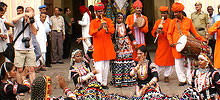
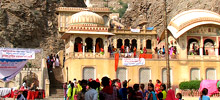
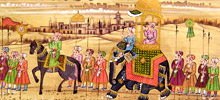
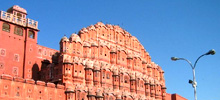
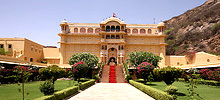
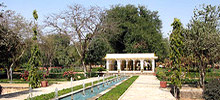
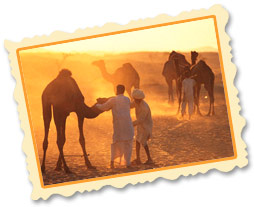 Jaipur, the Pink City is the capital and the largest city of Rajasthan. With fascinating forts, magnificent palaces; this place reflects a glorious and royal past. The flamboyance of turbans, eye catchy architecture, rich culture, textiles and jewellery attract a lot of national and international tourists. The brilliance of this city can only be experienced by witnessing it. Being the city of colours, fairs and fests, this wonderful city with a royal touch to it invites a huge crowd. Some of the prominent festivals that must be enjoyed, if you plan on visiting this place, are the Elephant festival, Teej festival, Kite festival, Gangaur festival, Camel festival. One should try and visit this land during the months of October to March, as the temperature varies between 22oC and 5oC at that time. This pleasant weather ensures that you witness the royal city of Rajasthan with complete delight.
Jaipur, the Pink City is the capital and the largest city of Rajasthan. With fascinating forts, magnificent palaces; this place reflects a glorious and royal past. The flamboyance of turbans, eye catchy architecture, rich culture, textiles and jewellery attract a lot of national and international tourists. The brilliance of this city can only be experienced by witnessing it. Being the city of colours, fairs and fests, this wonderful city with a royal touch to it invites a huge crowd. Some of the prominent festivals that must be enjoyed, if you plan on visiting this place, are the Elephant festival, Teej festival, Kite festival, Gangaur festival, Camel festival. One should try and visit this land during the months of October to March, as the temperature varies between 22oC and 5oC at that time. This pleasant weather ensures that you witness the royal city of Rajasthan with complete delight.



.jpg)
